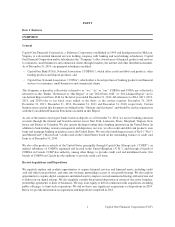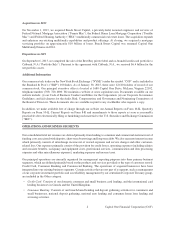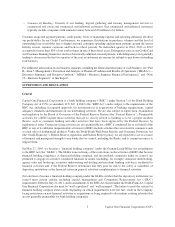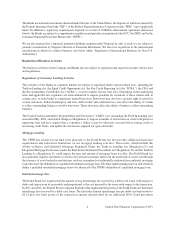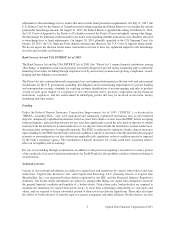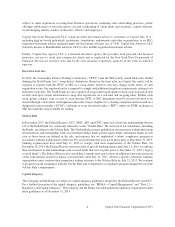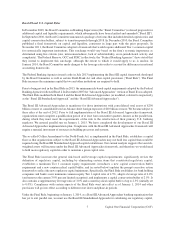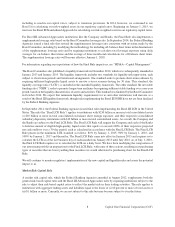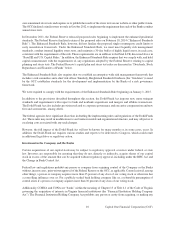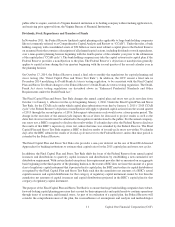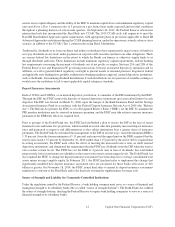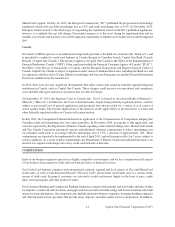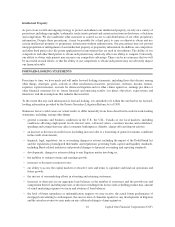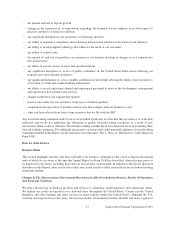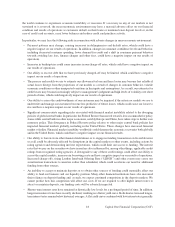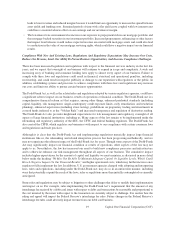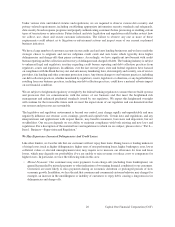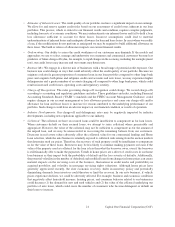Capital One 2014 Annual Report Download - page 33
Download and view the complete annual report
Please find page 33 of the 2014 Capital One annual report below. You can navigate through the pages in the report by either clicking on the pages listed below, or by using the keyword search tool below to find specific information within the annual report.public offer to acquire, control of a Virginia financial institution or its holding company without making application to,
and receiving prior approval from, the Virginia Bureau of Financial Institutions.
Dividends, Stock Repurchases and Transfers of Funds
In November 2011, the Federal Reserve finalized capital planning rules applicable to large bank holding companies
like us (commonly referred to as Comprehensive Capital Analysis and Review or “CCAR”). Under the rules, a bank
holding company with consolidated assets of $50 billion or more must submit a capital plan to the Federal Reserve
on an annual basis that contains a description of all planned capital actions, including dividends or stock repurchases,
over a nine-quarter planning horizon beginning with the fourth quarter of the calendar year prior to the submission
of the capital plan (“CCAR cycle”). The bank holding company may take the capital actions in its capital plan if the
Federal Reserve provides a nonobjection to the plan. The Federal Reserve’s objection or nonobjection generally
applies to capital actions during the four quarters beginning with the second quarter of the second calendar year in
the planning horizon.
On October 17, 2014, the Federal Reserve issued a final rule to modify the regulations for capital planning and
stress testing (the “Final Capital Plan and Stress Test Rule”). In addition, the OCC issued a final rule in
December 2014 modifying its Dodd-Frank Act stress testing regulation, to be consistent with the Final Capital
Plan and Stress Test Rule changes to the Federal Reserve’s Dodd-Frank Act stress testing regulation. The Dodd-
Frank Act stress testing regulations are described above in “Enhanced Prudential Standards and Other
Requirements under the Dodd-Frank Act.”
The Final Capital Plan and Stress Test Rule changes the annual capital plan and stress test cycle start date from
October 1 to January 1, effective for the cycle beginning January 1, 2016. Under the Final Capital Plan and Stress
Test Rule, for the CCAR cycle under which capital plan submissions were due by January 5, 2015 (“2015 CCAR
cycle”), the Federal Reserve’s objection or nonobjection will apply to planned capital actions from the second quarter
of 2015 through the second quarter of 2016. Subsequent submissions each would cover a four-quarter period. The
change in the start date of the annual cycle impacts the as-of dates for data used to project results as well as the
dates that stress test results must be submitted to the regulators and disclosed to the public. For the annual company-
run stress test, a BHC is required to disclose the results within 15 calendar days after the Federal Reserve discloses
the results of that BHC’s supervisory stress test, unless that time was extended by the Federal Reserve. The Final
Capital Plan and Stress Test Rule requires a BHC to disclose results of its mid-cycle stress test within 30 calendar
days after the BHC submits the results of its mid-cycle stress test to the Federal Reserve, unless that time period is
extended by the Federal Reserve.
The Final Capital Plan and Stress Test Rule also provides a one-year deferral on the use of Basel III Advanced
Approaches for banking institutions to estimate their capital ratios for the 2015 capital plan and stress test cycles.
In addition, the Final Capital Plan and Stress Test Rule shifts the focus of the Federal Reserve from annual capital
issuances and distributions to quarterly capital issuances and distributions by establishing a new cumulative net
distribution requirement. With certain limited exceptions, this requirement provides that-as measured on an aggregate
basis beginning in the third quarter of the planning horizon-to the extent a BHC does not issue the amount of a given
class of regulatory capital instrument that it projected in its capital plan, the BHC must reduce its capital distributions
as required by the Final Capital Plan and Stress Test Rule such that the cumulative net amounts of a BHC’s actual
capital issuances and capital distributions for that category of regulatory capital instrument cannot be less than the
cumulative net amounts of capital issuances and capital distributions projected in the BHC’s capital plan for that
category of regulatory capital instrument.
The purpose of the Final Capital Plan and Stress Test Rule is to ensure that large bank holding companies have robust,
forward-looking capital planning processes that account for their unique risks and capital needs to continue operations
through times of economic and financial stress. As part of its evaluation of a capital plan, the Federal Reserve will
consider the comprehensiveness of the plan, the reasonableness of assumptions and analysis and methodologies
11 Capital One Financial Corporation (COF)


